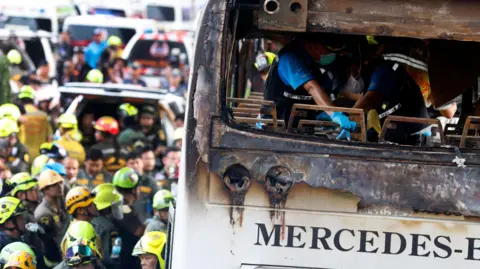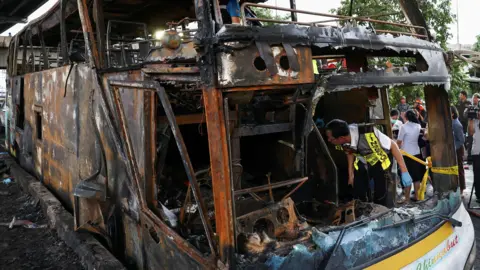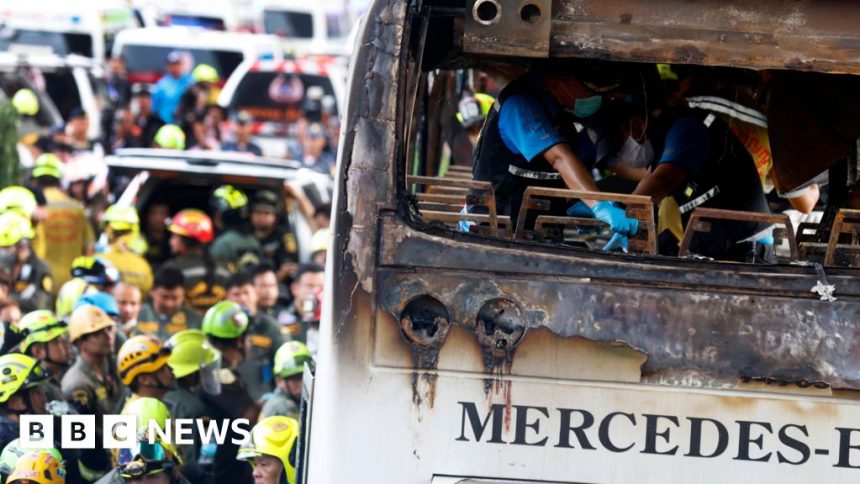Could the deaths of 20 school children help make Thailand’s roads safer?
 EPA
EPAThailand is a country in shock: three days ago, 20 children and three teachers were killed when their bus was engulfed in flames.
It was one of the South East Asian country’s worst road accidents, and investigators have uncovered a series of safety failures which some have suggested effectively turned the vehicle into a “bomb on wheels”.
It has left the country – still mourning the loss of the 23 on board the bus – wondering how this was ever allowed to happen, and if it could happen again?
Video taken of the bus, after the driver had collided with a concrete barrier and come to a stop, showed jets of fire shooting up from underneath the vehicle and turning it into an inferno within minutes, giving the passengers in the rear no chance of escape.
Investigators found the bus, which was converted to run on compressed natural gas (CNG), had six gas cylinders legally installed in the rear.
But they also found five more illegally fitted under the front of the bus.
The investigation found that a pipe coming from one of those in the front broke in the impact, leaking gas which ignited the fire. The trapped passengers appear to have been unable to open the rear emergency exit too, although it is not clear yet why.
The government responded by ordering all of the more than 13,000 public and private buses powered by CNG to come in for inspection, and suspended all long-distance school bus trips.
But the conversion to CNG was just one of many alterations made since the bus was first registered in 1970.
It was a kind of “franken-bus”, with new bodywork added several times, and only parts of the chassis remaining from the original.
It had once been a double-decker, but – when new regulations imposed height limitations on these because of their propensity to overturn in an accident – it was converted into a single-decker.
The passengers were still sitting on the upper deck, with the lower deck used to accommodate all the gas cylinders. Social media users have likened the bus to a bomb on wheels.
 Reuters
ReutersThis is despite Thailand’s gradual introduction over the past 15 years of regulations for bus safety laid out by the UNECE, the UN Economic Commission for Europe, a body responsible for establishing international standards in many areas. But application of these rules have been slow and piecemeal.
“The problem is most of the manufacturers in Thailand cannot reach that standard,” says Sumet Ongkittikul, a transport specialist at the Thailand Development Research Institute. “So the implementation has been delayed, to allow them to catch up.
“Also, the regulations only apply to new buses. But most of the buses operating in Thailand are old.”
What’s more, regulations only apply to new vehicles, and most of Thailand’s buses are old – at least partially. Modifying old bus chassis with new bodywork is a local industry, where safety standards are for the most part far behind those in many other countries.
It is thought that at least 80% of the buses connecting Thailand’s cities are in this older, adapted category.
“A new bus, from a good manufacturer, is very expensive,” Sumet Ongkittikul explains. “So they use an old chassis, and a local manufacturer to build new bodywork, and that is counted only as an old bus, where the new regulations do not apply.”
For example, UNECE regulation UN R118, which requires bus interiors to be made with non-flammable materials, was officially introduced in Thailand in 2022, but does not apply to buses made before then, or buses adapted using older chassis.
Less flammable materials might have helped mitigate the bus fire on Tuesday.
And even the very limited regulations which did apply to the ill-fated bus appear to have been broken.
According to the police, the bus was inspected in May this year, but they believe the illegal addition of gas cylinders was made after that.
Two days after the accident, the police say they caught the bus owner trying to remove improperly-installed gas cannisters from the five other buses.
The company has had its licence to run buses suspended, and the owner has been charged with causing death through negligence, with other criminal charges being considered.
But will this accident finally bring about a change in Thailand’s dire road safety record?
 Reuters
ReutersThe country is currently on its fifth National Road Safety Master Plan, but with little progress to show for it.
For years, it has sat in the top 10 countries with the highest per capita road fatalities. At times, it has been number two.
Data from the TDRI found that over the 10 years to 2023, an average of 17,914 people died from road accidents per year.
In the UK, which has a similar population, fatalities are 10 times lower.
Anyone who travels regularly on Thai roads will be familiar with the dangerous behaviour habitually exhibited by many drivers.
Exceeding the speed limit is commonplace and rarely punished. Cars weave in and out of traffic, leaving little margin for error. Commercial vehicles are often overloaded, badly designed and poorly lit. Motorbike riders routinely fail to wear helmets, far more than in neighbouring countries.
Some blame corruption in the police force. Others blame the Buddhist belief in karma, putting misfortunes like car accidents down to bad luck rather than bad habits.
Although there are posters graphically warning of the dangers of drinking and driving, there has also not been a sustained road safety campaign mounted by any Thai government. Some researchers believe this is because most fatalities, on motorbikes and on public buses, affect lower income groups, and not the policymakers who usually drive, or are driven, in high-end cars with high safety levels.
 Getty Images
Getty ImagesFor all of the appalling statistics, road safety is not seen as an urgent issue, and gets little attention from the public.
There have been plenty of equally horrific accidents before involving long-distance buses, yet they are little safer today than they were 10 years ago.
Transport Minister Suriya Jungrungreangkit has announced a special committee to look into all aspects of road safety following Tuesday’s fatal accident, but it has been greeted with little fanfare or enthusiasm.
If this initiative really does bring about meaningful improvements, and bring down the annual death toll, it will break the pattern of ineffectual measures which have characterised nearly all of Thailand’s road safety efforts to date.







